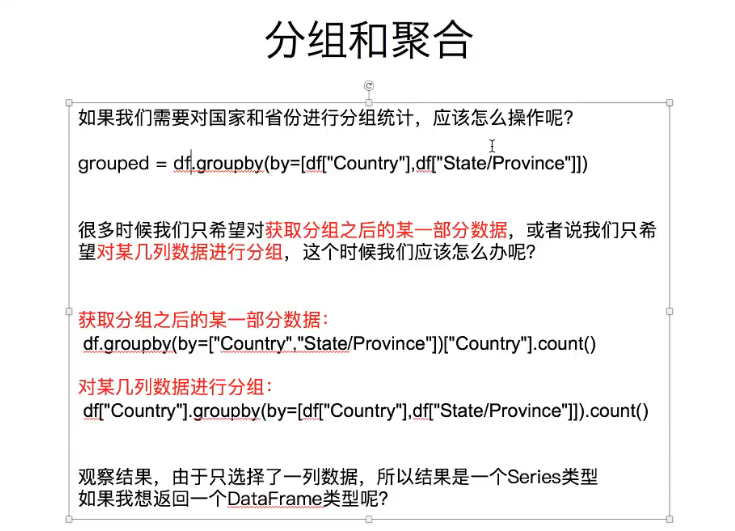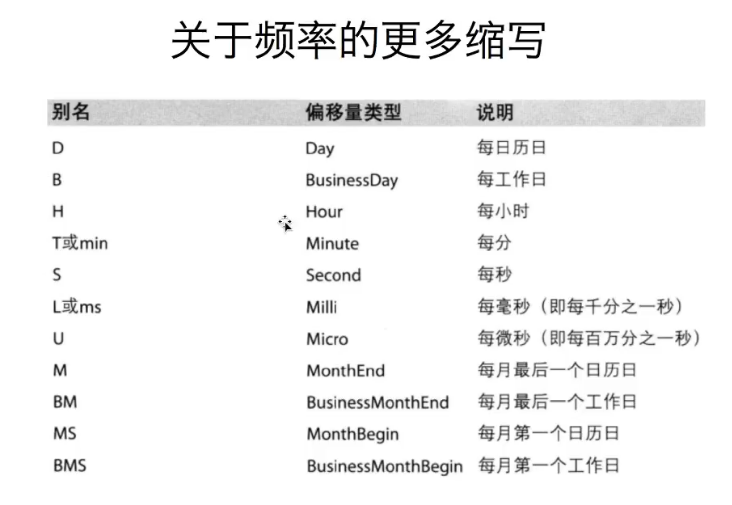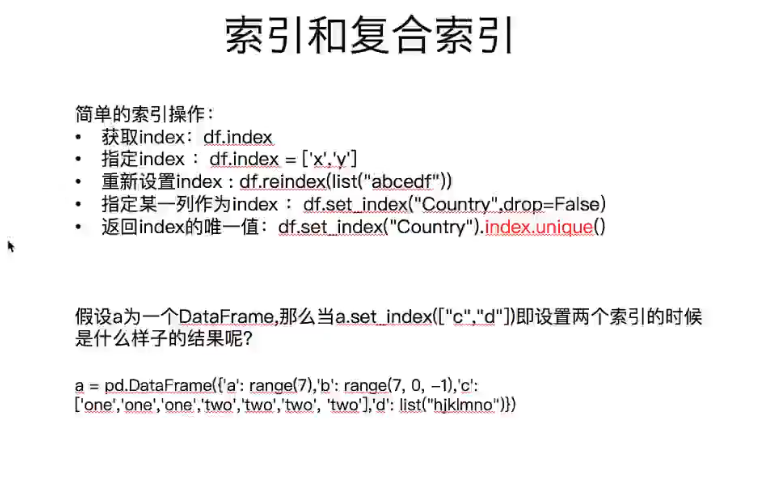1. matplotlib ->绘图
2. numpy -> 处理数值型数组
3. pandas -> 处理字符串, 时间序列、字典等
三、pandas 学习
numpy 帮我们处理数值型数据, pandas 可以帮我们处理字符串、时间序列等。
一、常用数据类型
-
Series 一维, 由 "索引" 跟 "值" 组成。
-
使用列表或numpy对象
pd.Series([1,2,3,4,5], index=list("abcde"))
-
import pandas as pd
pd.Series([1,2,3,4,5], index=list("abcde"))
# 结果
a 1
b 2
c 3
d 4
e 5
dtype: int64
----不指明索引默认使用 0,1,2,3,4 下标
----第一个参数可以是nump 对象
-
使用字典对象, key 作为索引, value 作为值
In [62]: dict_tmp = {"name": "小明", "age":18} In [63]: pd.Series(dict_tmp) Out[63]: name 小明 age 18 dtype: object -
切片和索引
a = pd.Series(dict_tmp)a[0] # 下标取值 a["name"] # 索引取值 --------- In [78]: a[["name", "age"]] # 根据索引取多个 Out[78]: name 小明 age 18 dtype: object --------- In [79]: a[[0, 1]] # 根据下标取多个 Out[79]: name 小明 age 18 dtype: object --------- In [81]: a = pd.Series(range(10)) In [82]: a[a> 5] # 布尔索引 Out[82]: 6 6 7 7 8 8 9 9 dtype: int64切片和python一样
5. pandas读取外部数据
pd.read_csv() # 读取csv
import pandas as pd
df = pd.read_csv("./data/1.csv")# 有好多read_... 方法
print(df)
####结果
品名 最低价 平均价 最高价 规格 单位 发布日期
0 大白菜 0.4 0.50 0.6 存储 斤 2021-03-25 NaN
1 大白菜 0.7 0.75 0.8 新 斤 2021-03-25 NaN
2 娃娃菜 0.6 0.75 0.9 大小 斤 2021-03-25 NaN
3 芹菜 0.8 0.90 1.0 鲁 斤 2021-03-25 NaN
4 菠菜 0.7 1.00 1.3 长杆冀 斤 2021-03-25 NaN
5 番茄 1.0 1.40 1.8 川鲁蒙 斤 2021-03-25 NaN
6 番茄(精品) 1.5 1.75 2.0 普通 斤 2021-03-25 NaN
7 黄瓜 1.6 1.90 2.2 蒙辽袋鲁 斤 2021-03-25 NaN
8 黄瓜(鲜干花) 2.6 2.90 3.2 冀 斤 2021-03-25 NaN
9 小黄瓜 4.0 5.50 7.0 旱荷兰 斤 2021-03-25 NaN
10 茄子 1.2 1.70 2.2 鲁冀 斤 2021-03-25 NaN
11 架豆 2.6 3.70 4.8 冀 斤 2021-03-25 NaN
12 尖椒 1.4 1.95 2.5 冀晋/鲁新 斤 2021-03-25 NaN
13 柿子椒 1.4 1.85 2.3 鲁新 斤 2021-03-25 NaN
14 土豆 0.6 0.80 1.0 冀 斤 2021-03-25 NaN
15 新土豆 0.7 0.95 1.2 陕冀云新 斤 2021-03-25 NaN
16 黄葱头 0.8 1.00 1.2 蒙甘 斤 2021-03-25 NaN
17 红葱头 0.9 1.15 1.4 普通 斤 2021-03-25 NaN
18 葱 3.5 3.75 4.0 冀/苏鲁闽 斤 2021-03-25 NaN
19 吊冬瓜 1.7 1.95 2.2 桂 斤 2021-03-25 NaN
DataFrame 二维, Series容器
1.创建
In [4]: import numpy as np
In [5]: import pandas as pd
In [6]: a = pd.DataFrame(np.arange(12).reshape(3,4))
In [7]: a
Out[7]:
0 1 2 3 # 列索引
0 0 1 2 3
1 4 5 6 7
2 8 9 10 11
#行索引
- 参数index, 行索引
- 参数columns, 列索引
- dtype
In [20]: b = pd.DataFrame(np.arange(12).reshape(3,4), index=list("abc"), columns=list("wxyz"))
In [21]: b
Out[21]:
w x y z
a 0 1 2 3
b 4 5 6 7
c 8 9 10 11
传入字典
方式一、
In [24]: a = {"name": ["小红", "小明", "小刚"], "age": [18,19,20]}
In [25]: b = pd.DataFrame(a)
In [26]: b
Out[26]:
name age
0 小红 18
1 小明 19
2 小刚 20
方式二、
In [31]: c = [{"name": "小明","age": 18}, {"name":"小刚", "age":20}]
In [32]: d = pd.DataFrame(c)
In [33]: d
Out[33]:
name age
0 小明 18
1 小刚 20
2. DataFrame 操作
a.head(3) # 显示前几行, 默认前5行
a.tail(3) # 显示末尾几行, 默认后5行
a.info() # 查看信息概览: 行数,列数,列索引,列非空值个数,列类型,内存占用
a.describe() # 快速综合统计结果: 技术,均值,标准差,最大值,四分位数, 最小值
a.sort_values(by="排序的字段", acsending=True) # 升序排序,并指明排序字段
a[:] # 切片
d[:1] # 取值行
------
name age
0 小明 18
d[:1]["age"] # 取行+列
d["age"] # 取列
根据索引取值:
b.loc[[0,1], [1,2]] # 通过标签索引行数据, 选取第0,1行, 第1,2列,这里0,1 是指索引值
z = pd.DataFrame(np.arange(12).reshape(3,4), index=list("abc"), columns=list("wxyz"))
z.loc["a",:] # 取第a行的所有列z.loc[["a", "b"],:]
z.loc["a":"c",["w", "z"]] # 从第a行到第c行(c可以取到)的w,z列,
根据位置获取行
z.iloc[[0,2], [2,1]] # 这里的 0,2 1 指得是行数和列数
z.iloc[1:,:2] # 取第一行之后,第二列之前的所有列
# 当列索引和行索引相同的时候默认取得是列
b = pd.DataFrame(np.arange(12).reshape(3,4))
------
Out[90]:
0 1 2 3
0 0 1 2 3
1 4 5 6 7
2 8 9 10 11
b[0] # 取值
--------
Out[91]:
0 0
1 4
2 8
Name: 0, dtype: int32
In [41]: d.describe()
Out[41]:
age
count 2.000000
mean 19.000000
std 1.414214
min 18.000000
25% 18.500000
50% 19.000000
75% 19.500000
max 20.000000
In [42]: d.info()
<class 'pandas.core.frame.DataFrame'>
RangeIndex: 2 entries, 0 to 1
Data columns (total 2 columns):
# Column Non-Null Count Dtype
--- ------ -------------- -----
0 name 2 non-null object
1 age 2 non-null int64
dtypes: int64(1), object(1)
memory usage: 160.0+ bytes
布尔索引
df[ (df["品名"].str.len() > 2) & (df["品名"].str.len() < 4) ]
# 选取品名长度 > 2 并且<4 的值, 在布尔索引中将每一个判断条件用() 括起来
(df["品名"].str.len() > 2)
&
(df["品名"].str.len() < 4)

.tolist # 将其转换为一个列表
查看index
a.index # 可以迭代的, 也可以用切片
a.colums #查看列索引
查看值
a.values # 可以遍历,切片索引
缺失数据处理:
-
NaN
pd.isnull() # 判断为nan的方式 pd.notnull() # 判断不为nan的方式 d[pd.notnull(d["w"]) # 选择d, w列不为nan的列 a[pd.notnull(a["w"])] # 选取w列不为 Nan 的列删除
a.dropna(axis=1. how="any", inplac=True) # 删除包含nan的列 # how = "any" 指只要有nan就删掉, how="all" 指全部是Nan的时候才删除 # inplace =True 指修改源数据, =False 不修改源数据替换
a.fillna(100) # 将100 放到为 nan的位置 # 一般填充均值或中位数 a["w"] = a["w"].fillna(t2["w"].mean()) # 只修改w这一列, 并将这一列的结果赋给w这一列 -
0
使用布尔索引给0重新赋值,如果是确定数据确实的时候一般赋值位 Nan
数据合并
.join (行索引,数据组合)
默认情况下他是把行索引相同的数据合并到一起。
In [44]: t1
Out[44]:
w x y z
A 1.0 1.0 1.0 1.0
B 1.0 1.0 1.0 1.0
In [45]: t2
Out[45]:
a b c
A 0.0 0.0 0.0
B 0.0 0.0 0.0
C 0.0 0.0 0.0
In [46]: t1.join(t2) # 以t1 为基准,没有的赋值位Nan
Out[46]:
w x y z a b c
A 1.0 1.0 1.0 1.0 0.0 0.0 0.0
B 1.0 1.0 1.0 1.0 0.0 0.0 0.0
# 以join 前的为基准,没有的赋值位Nan
# 不能有相同的列 标识 (cloumns)
.merge (列索引, 数据组合)
In [135]: t1
Out[135]:
a b c d
z 1.0 1.0 1.0 1.0
y 4.0 1.0 1.0 1.0
0 5.0 6.0 7.0 8.0
In [136]: t2
Out[136]:
f a g
a 0 1 2
b 3 4 5
c 6 7 8
In [137]: t1.merge(t2, on="a", how="inner") # 根据a列合并,并且根据列项上的值合并, 之合并相等的, on 参数可以去掉, how="inner" 表示内连接, 默认为内连接, how="outer" 指外连接, how="left" 左连接, how="right" 右链接
Out[137]:
a b c d f g
0 1.0 1.0 1.0 1.0 0 2
1 4.0 1.0 1.0 1.0 3 5
In [141]: t1.merge(t2, on="a", how="outer") # 以a 为基准的外连接
Out[141]:
a b c d f g
0 1.0 1.0 1.0 1.0 0.0 2.0
1 4.0 1.0 1.0 1.0 3.0 5.0
2 5.0 6.0 7.0 8.0 NaN NaN
3 7.0 NaN NaN NaN 6.0 8.0

分组和聚合
.groupby(by="分组字段") # by = [] # 对多个字段分组


时间序列
pd.data_range(start=None, end=None, periods=None, freq="D")
start 开始时间
end 结束时间
periods 个数
freq 单位
例1: 从2018 年12月1号到2019年1月1号以天为单位的时间
In [223]: pd.date_range(start="20181201", end="20190101", freq="D")
Out[223]:
DatetimeIndex(['2018-12-01', '2018-12-02', '2018-12-03', '2018-12-04',
'2018-12-05', '2018-12-06', '2018-12-07', '2018-12-08',
'2018-12-09', '2018-12-10', '2018-12-11', '2018-12-12',
'2018-12-13', '2018-12-14', '2018-12-15', '2018-12-16',
'2018-12-17', '2018-12-18', '2018-12-19', '2018-12-20',
'2018-12-21', '2018-12-22', '2018-12-23', '2018-12-24',
'2018-12-25', '2018-12-26', '2018-12-27', '2018-12-28',
'2018-12-29', '2018-12-30', '2018-12-31', '2019-01-01'],
dtype='datetime64[ns]', freq='D')
例2: 从2018 年12月1号到2019年1月1号以天为单位的时间, 间隔5天
In [224]: pd.date_range(start="20181201", end="20190101", freq="5D")
Out[224]:
DatetimeIndex(['2018-12-01', '2018-12-06', '2018-12-11', '2018-12-16',
'2018-12-21', '2018-12-26', '2018-12-31'],
dtype='datetime64[ns]', freq='5D')
例3: 间隔5个月
In [225]: pd.date_range(start="20181201", end="20191201", freq="5M")
Out[225]: DatetimeIndex(['2018-12-31', '2019-05-31', '2019-10-31'], dtype='datetime64[ns]', freq='5M')
例4: 从2018 年12月1号起每隔5个月取一个共取10个
In [226]: pd.date_range(start="20181201", periods=10, freq="5M")
Out[226]:
DatetimeIndex(['2018-12-31', '2019-05-31', '2019-10-31', '2020-03-31',
'2020-08-31', '2021-01-31', '2021-06-30', '2021-11-30',
'2022-04-30', '2022-09-30'],
dtype='datetime64[ns]', freq='5M')

字符串转换为时间序列
pd.to_datetime("指明列", format="")
一般format 不需要指明,当时间字符串里有中文的时候需要指明。
format 和python 时间戳格式化一样
将秒级时间转换为月级( 降采样, 反之为升采样)
.resample("频率单位") # 注意这里只能转换,index, 所以想转换之前先使用set_index 将相应的列设置为index
index 操作
